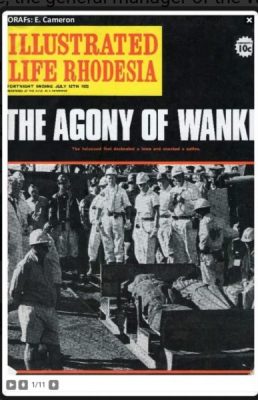Kamandama disaster HCCL safety & health policies implementation

June 6, 1972 saw the disaster at Wankie Colliery where 427 miners lost their lives.
The Wankie coal mine disaster took place on 6 June 1972 when a series of underground explosions occurred at the Wankie No.2 colliery in Rhodesia (now known as Zimbabwe). With 427 fatalities, it remains the deadliest mine accident to date in the country’s history.
Historical records established that the accident was caused by an underground methane dust explosion and despite the several attempts by the then PROTO teams to rescue mine workers, the fatality of the disaster was such that the mine shaft had to be sealed off.
The disaster took place at the Wankie No.2 Colliery in Wankie, (now known as Hwange) in the Rhodesian province of Matabeleland North, when several gas explosions ripped through the mine. It was initially believed that more than 470 miners were trapped, but the number was lowered after the owners found a number of people had shown up for work.
Eight men were pulled alive from the mine after the initial explosions. Two new explosions on 7 June poured clouds of poisonous gas into the 3 miles (4.8 kilometres) of tunnels, making further rescue attempts impossible.
On 9 June, the general manager of the Wankie Colliery, Gordon Livingstone-Blevins, decided to leave the 424 bodies where they were. Three bodies had been recovered after the initial explosions. A mass memorial service took place on 11 June at a nearby football stadium, where a crowd of about 5,000 people paid tribute. “This has cast a gloom over the whole country,” Rhodesian Prime Minister Ian Smith said during the service.
KAMANDAMA DISASTER COMMEMORATIONS
Hwange Colliery Company Limited annually gathers to commemorate the lives of the 427 dedicated and hardworking miners who lost their lives in the Kamandama No 2 Underground shaft in 1972. The miners perished while moving the economic wheels of the nation and region at large.
The aftermath of the Kamandama mine shaft disaster saw Hwange Colliery Company play a critical role in the implementation and monitoring of safety and health policies in the mining sector for the benefit of the mining industry in Zimbabwe. Safety, Health and Environmental sustainability have since become a topical issue at national, regional and international levels following this disaster.
- As a result Associations such as the Mine Rescue Association of Zimbabwe; founded in 1973 whose mandate is to coordinate mine rescue activities in the country were formed. The disaster was ranked as the eighth biggest tragedy in the world in 2015 with the highest-ranked being the Honkeiko mine disaster in China, where 1 549 lives were lost on 26 April 1942 according to media reports.
- The Memorial service event is attended by Board Members, Management, Widows of the Disaster, Worker Leadership, Mining cluster, Local Government, State Entities, Government Departments, Local Traditional Chiefs, the Hwange Business Community, and Electronic and Print media. A Memorial Golf Tournament is held annually before the commemorations to raise funds towards the cause of the widows and dependents who are assisted through the Human Resources department. The tournament is now a flagship event for over 100 golfers yearly who display their skills in remembrance of the day.
LESSONS LEARNT
- The company has learnt its lessons from the Kamandama mine disaster of 1972 and since then, great efforts have been made to ensure that there would never be repeat accidents in any of the Company`s mines or workstations.
- The statutory regulation for coal mines and fiery mines was drastically changed and adopted as more mines were declared fiery. Fiery mines were categorized to have methane and any other inflammable gases as well as mines containing coal dust. Mine Rescue was born out of the 1972 disaster, at the time, there were no rescue teams in the country and rescue teams responded from Zambia, South Africa and Botswana.
- The company has established a fully-fledged Safety, Health, Environment and Quality Department with competent practitioners who drive various proactive accident preventive strategies.
- The company has clear leadership, comprehensive safety programmes as well as a 100 per cent commitment by management and staff to zero tolerance towards unsafe working practices and zero targets for injuries, while also cementing constructive interaction with workers’ unions on safety.
Notable improvements at HCCL from Kamandama Mine Disaster to date:
- Flame Proof Equipment use – only underground.
- Stone Dust Application.
- Senior supervision i.e. stringent conditions during any flame cutting and welding activities underground
- All workers who operate electrical machines are trained and equipped to test for gases.
- Banning of contraband entering the mine.
- Establishment of mine rescue teams to assist in times of disaster.
- Construction of refuge chambers.
- Flame Proof Machinery
Drill and blasting were eliminated in normal production activities and replaced by electrically powered continuous mining technology. All the machines are flameproof meaning any short circuit in electrical panels won’t interact with the underground atmosphere. Inflammable gases and methane are known to lead to catastrophic explosions if ignited.
All electrical fittings including bulbs, fluorescent tubes and distribution boxes are made up of a special specification designed from heavy steel which is at least 25mm in thickness. All electrical cabling is of special design; armoured and fire retardant.
- Stone Dust Application
Stone dusting was introduced in Zimbabwe after the Kamandama Disaster which is an application of very fine limestone dust on all the excavations carried out in coal mines. The limestone controls the propagation of fires and explosions in a coal mine as limestone is inert and incombustible. An array of activities are carried out in sampling and monitoring of the limestone quality before and after application in the mine.
- Good ventilation
Good ventilation supplies fresh air to dilute methane or inflammable gases to less than 1.25% in the ambient atmosphere of coal mines. The mine employs high technical personnel who make sure the mine is well ventilated every second and hour of the day. Ventilation is the primary activity in coal mining and takes precedence over all activities in underground processes. High tech fans are used for main ventilation and auxiliary ventilation.
- Emergency preparedness
The underground coal mines are designed to allow at least two means of ingress and egress. Channels of getting into and out of the mine should be as close as possible to the work areas. The escape routes are clearly marked and easily identifiable.
- The company strives to equip all miners, contractors and visitors with appropriate skills of enabling their safe escape when caught in an emergency situation. All persons proceeding underground are issued with a serviceable rescue pack and cap lap. A Rescue pack allows all persons to pass through irrespirable atmospheres in any emergency in order to reach safe places or refuge bays or safe-havens.
- The company has functional rescue teams ready to respond and save lives as well as property. The teams are part of a response zone in the country. They are highly trained and comprised of technical individuals from various professional sectors.
Source: Hwange Website


